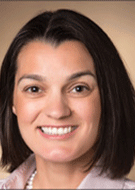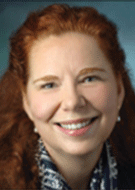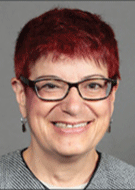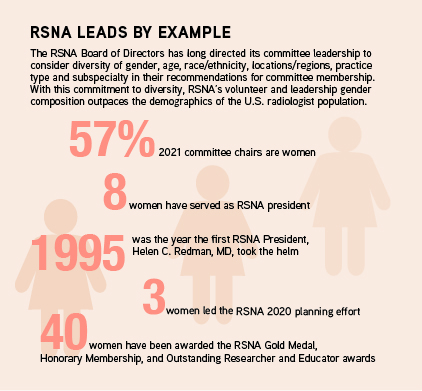Diverse Teams Lead to Innovation, Staff Retention
Experts offer guidance for improving diversity in radiology departments




There are benefits to a diverse workforce that are not being realized in the field of radiology.
“Women and minority groups remain grossly underrepresented in the field of radiology,” said Lucy B. Spalluto, MD, MPH, associate professor of radiology and radiological sciences at Vanderbilt University Medical Center and president of the American Association for Women in Radiology (AAWR). “Improving diversity and inclusion in radiology represents an opportunity to enhance innovation, enrich the learning environment, and improve patient outcomes.”
In contrast, the business sector uses diversity as a driver of equity and excellence, explained Katarzyna J. Macura, MD, PHD, professor of radiology, urology and oncology at Johns Hopkins University, in an RSNA 2020 session.
“Large global enterprises believe diversity is crucial for fostering innovation, increased creativity, making recruitment of talent easier, avoiding high turnover and capturing more market share,” said Dr. Macura, past president of the AAWR.
A study recently reported by Forbes concluded diverse teams make better decisions 87% of the time compared to homogenous, all-male teams.
“The health sector can achieve the same gains,” Dr. Macura said. “Studies show that students trained at diverse medical schools are more comfortable treating patients from a wide range of ethnic backgrounds. Patients must see themselves in the health care workforce and our workforce needs to resemble the patients they serve.”
Of the 2019 class of medical school graduates, 47.9% were female. Despite the available pipeline, women remain underrepresented in both diagnostic radiology and radiation oncology.
“There’s an untapped opportunity to attract more women into our specialty of radiology,” Dr. Macura said.
Watch Dr. Spalluto discuss the steps to take and the challenges to be faced when radiology departments and practices build diverse workforces.
Diversity in Radiology Lags Behind Other Specialties
Data from the American Association of Medical Colleges shows that one out of every two medical school graduates are women and one out of 10 are from racial and ethnic populations that are under-represented in medicine. Recent studies looking at specific subspecialties noted that in the case of radiology and radiation oncology, the numbers are lower. One out of four graduates in those fields are female and only one out of 14 to 15 graduates are from under-represented groups.
“When we compare these numbers, it speaks to a loss of diversity and a loss of talent in our field,” said Pari Pandharipande, MD, MPH, director of the Institute for Technology Assessment at Massachusetts General Hospital.
Results of an American College of Radiology (ACR) membership survey designed to identify potential barriers to building a diverse physician workforce illustrates the issue. The national ACR survey conducted in 2018 queried members about their attitudes toward their work environment, relationships and culture. About half of 461 respondents were women and 9.5% identified as being from racial and ethnic populations that are under-represented in medicine. Both groups were much more likely to report unfair and disrespectful treatment in the workplace and fewer available career advancement opportunities.
A high proportion of all respondents said colleagues or coworkers tell offensive jokes or stories or make insulting comments about race or ethnicity.
“These findings speak to a need for a change in culture,” Dr. Pandharipande said. “Formulating strategies to identify and address the sources of this problem should represent a top priority in our profession.”

And change begins with leadership, according to Carolyn C. Meltzer, MD, chair of radiology and imaging sciences at Emory University School of Medicine and a member of the RSNA Board of Directors.
“We know from business literature how important diversity and inclusion is to getting the best talent, having the most innovative ideas and being recognized as a best place to work,” Dr. Meltzer said.
She challenged radiologists to think about what their departments look like in terms of representation and the messages reflected in the workplace.
“What do we revere? What is our language like? Do we have gender neutral restrooms? Lactation spaces? Culture is very important,” she said.
Dr. Meltzer also stressed the need to consider the full professional life cycle of a radiologist, recruiting broadly and supporting radiologists throughout their careers. She advocates for valuing candidates who offer a different perspective and cultural lens during recruitment and investing in leadership development, mentorship and sponsorship to improve staff retention.
Several programs are successfully reaching out to medical students about careers in radiology, including the Society of Chairs of Academic Radiology Departments LEAD program, ACR PIER Program, the Moorehouse School of Medicine Totally Rad program and Emory University’s annual medical student career symposium. “Getting students excited about technologies like AI and what we’ll do to guide them going forward is very impactful,” she said.
She concluded with actionable steps everyone can take to practice inclusive leadership, from awareness training for unconscious bias and how it can creep into our processes to the deliberate formation and care-and-feeding of diverse teams.
“We need to advocate and amplify women and unrepresented colleagues to ensure increased exposure of counterstereotype exemplars, like women chairs, as role models,” Dr. Meltzer said.
For More Information
Watch the RSNA 2020 panel discussion, "Building a Diverse Radiology Workforce," at RSNA2020.RSNA.org.
Access RSNA Online Learning Center resources on diversity at RSNA.org/Learning-Center-Diversity.
Read previous RSNA News articles on diversity in the workforce:
- Embracing Diversity, Equity and Inclusion in Radiology
- Leaders Find New Ways to Inspire Next-Generation Radiologists
- My Turn: The RSNA Committee on Diversity and Inclusion Gets Off to a Strong Start